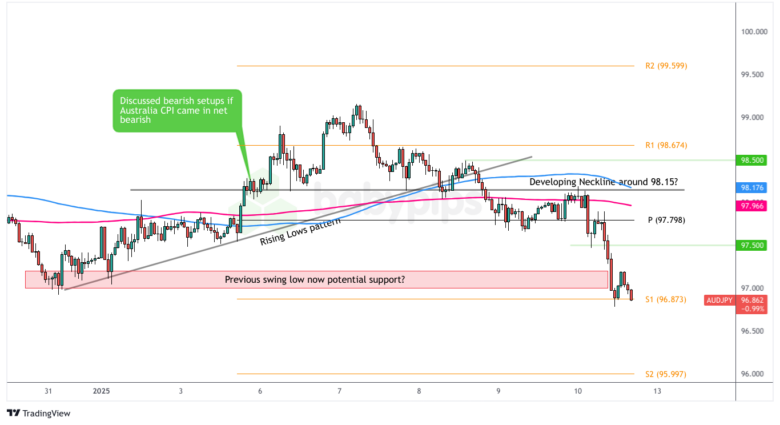
This week our currency strategists focused on the Australian CPI update for potential high-quality setups in the Aussie dollar.
Out of the four scenario/price outlook discussions this week, two discussions arguably saw both fundie & technical arguments triggered to become potential candidates for a trade & risk management overlay. Check out our review on those discussions to see what happened!
Watchlists are price outlook & strategy discussions supported by both fundamental & technical analysis, a crucial step towards creating a high quality discretionary trade idea before working on a risk & trade management plan.
If you’d like to follow our “Watchlist” picks right when they are published throughout the week, you can subscribe to BabyPips Premium.
AUD/JPY: Monday – January 6, 2025
Last week our currency strategists focused on the Australian CPI update and its potential impact on the Australian dollar. Based on our Event Guide, expectations were for headline CPI to tick up from 2.1% to 2.2% y/y in November 2024, with the monthly reading expected at 0.2%.
Based on the analysis from the Event Guide, here are the scenarios we were watching:
If the CPI came in hotter than expected, we anticipated this could weigh against speculation of near-term RBA rate cuts. We focused on AUD/CHF for potential long strategies if risk sentiment was positive, particularly given the SNB’s recent dovish stance and rate cut plans.
In a risk-off environment, AUD/CAD long was our pair of choice given uncertainties surrounding PM Trudeau’s potential resignation weighing on CAD at that moment.
If Australia’s inflation data disappointed or aligned with RBA’s projection of inflation returning to target, we thought this could fuel RBA easing expectations. We considered EUR/AUD for potential short strategies in a risk-on environment, particularly given the ECB’s measured approach to policy changes.
If broad risk sentiment leaned net negative, AUD/JPY short made sense given JPY’s status as a “safe haven” asset and recent rising speculation of potential BOJ interest rate hikes and verbal intervention supporting JPY.
What Actually Happened:
The November Australian CPI report showed mixed but generally above-expectation results:
- Annual inflation accelerated to 2.3% y/y (vs 2.2% expected)
- Monthly CPI rose 0.3% m/m (vs 0.2% forecast)
- Data wasn’t strong enough to significantly alter RBA rate cut expectations
Market Reaction:
While we did see better-than-expected reads, the markets didn’t seem to think they were strong enough to cancel expectations of RBA rate cuts based on the bearish reaction in the Australian dollar. And with broad risk sentiment turning cautious ahead of key U.S. data, AUD/JPY short setups became our focus, and this week we created a trade management case study around those bearish expectations.
Looking at the AUD/JPY chart, we saw immediate selling pressure after the CPI release with the pair dropping from around 98.50 area, and with the market souring on rising bond yields and rising odds of Fed rate cuts being pushed back, broad risk sentiment definitely soured this week.
The yen’s gains were amplified by Finance Minister Kato’s warning about potential intervention against excessive currency moves, while RBA officials maintained their dovish stance. AUD/JPY made fresh weekly lows below S1 (96.87) during Friday’s session as broad USD strength and fading Fed rate cut expectations after a strong U.S. jobs report influenced cross-rate flows.
The Verdict:
So, how’d we do? Our fundamental analysis anticipated potential AUD weakness if the CPI print wasn’t strong enough to shift RBA rate cut expectations, which played out as expected. Our technical analysis accurately identified key support and resistance levels around the pivot point and S1 that came into play.
If traders entered short positions after the initial break below the pivot point, they could have captured a substantial move lower. The trade management would have been relatively straightforward given the clear downward momentum and technical levels providing guidance.
Conservative traders who were looking for a bounce before shorting (like we did in our case study) would have missed the move lower, but active managers who stayed on the pair could have seem multiple opportunities to short again right around the Pivot Point and SMA area ahead of the U.S. jobs report
Overall, we think this discussion “highly likely” supported a net positive outcome as both fundamental and technical triggers aligned well, showing strong bearish momentum and hitting multiple support targets throughout the week.




